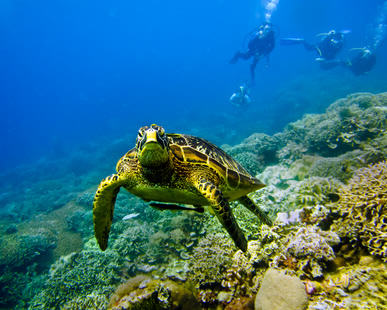I walked over to the nearby beach and right there near the shore I saw a huge Hawaiian sea turtle. I couldn’t believe it was so close! I was so fascinated that I wanted to learn more about these gentle marine reptiles that are so common seen in Hawaiian waters.
Hawaiian sea turtles weigh only about 1 ounce at birth, but adults may weigh up to 500 pounds. A healthy Green sea turtle may reach 60 years of age, and some may live more than 100 years. Male sea turtles have a tail while females do not.
Then I saw its huge shell, or carapace. The shell of an adult Green sea turtle is typically brownish-colored and flecked with olive and gold colors. The turtle’s underside, which is called the plastron, is yellowish-white in color.
The coloring of the sea turtle’s carapace and plastron provide effective camouflage from creatures both above and below. The “Green” in their name comes not from their shell color, but instead from the color of their flesh.
Hawaiian Green sea turtles are omnivores when they are young, surviving on fish eggs and also plankton that float near the water’s surface. This sea turtle I was watching was just floating near the surface, occasionally diving under but the soon reappearing.
Once the turtles mature they become vegetarians, feasting on limu pastures, which are beds of algae growing on underwater coral reefs and nearshore rocks.
Green sea turtles may stay underwater for more than three hours before coming to the surface for air.
Every two to three years, mature Green sea turtles around the main Hawaiian Islands swim about 700 miles to the Northwestern Hawaiian Islands’ French Frigate Shoals, where the great majority of Hawaiian Green sea turtles lay their eggs. The male sea turtles accompany the females, sometimes mating with them offshore near the nesting beaches.
Hawaiian Green sea turtles are known to return to the exact beach where they were born to lay their eggs, and this is called site fidelity. Female Green sea turtles lay their eggs between May and September. To lay their eggs the sea turtles dig a small pit on the shore in the sand. Then the sea turtle deposits 100-200 eggs up to 3 feet deep in the sand.
The eggs are white, very white, and they are about the size of ping-pong balls. A deposit of eggs is known as a clutch, and the female turtle may lay and bury up to six clutches along the beach over a several week period.
Sea turtle eggs incubate beneath the sand for about two months before they hatch. Then the eggs hatch all at the same time. Can you imagine all of those little sea turtles under the sand.
Then all together the tiny hatchlings, each only weighing about 1 ounce, begin to dig their way to the surface.
The hatchlings stop digging when only about 1 inch of sand is left above them all. Then they wait for darkness. At night the hatchlings break through the final layer of sand, emerge onto the beach, and then scurry for the water.
Birds, ghost crabs, and a variety of other predators may prey on the turtle hatchlings on the beach as they head for the water after hatching. Reef fish or sharks may capture the hatchling once it makes it to the water, but if the baby turtle survives the first few years, its only predators will be sharks and humans.
Also seen in Hawaiian waters are Hawksbill sea turtles. They are very endangered, with only about 30 nesting females left in Hawaiian waters. Most of the surviving Hawksbills nest on just a few remote beaches on the island of Hawaii (the Big Island). The Hawaiian name of the Hawksbill sea turtle is honuea.
Hawksbill sea turtles have a distinctive pointed beak, which they use to search the coral reefs for sponges, anemones, and other bottom-dwelling invertebrates.
Well I really appreciate being in such a beautiful place where I can see sea turtles. As I sit here now on the lanai of my Kauai Vacation Rental I look forward to tomorrow when I am going to go walking along the shoreline again looking for the beautiful honu.

